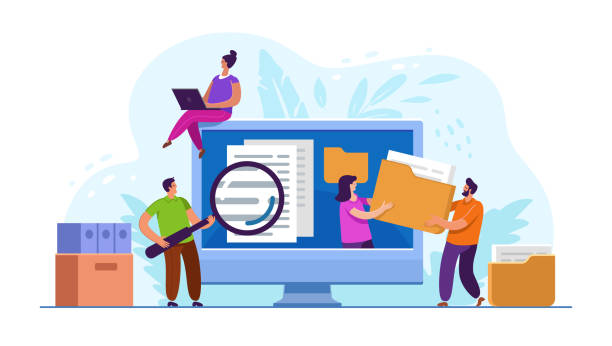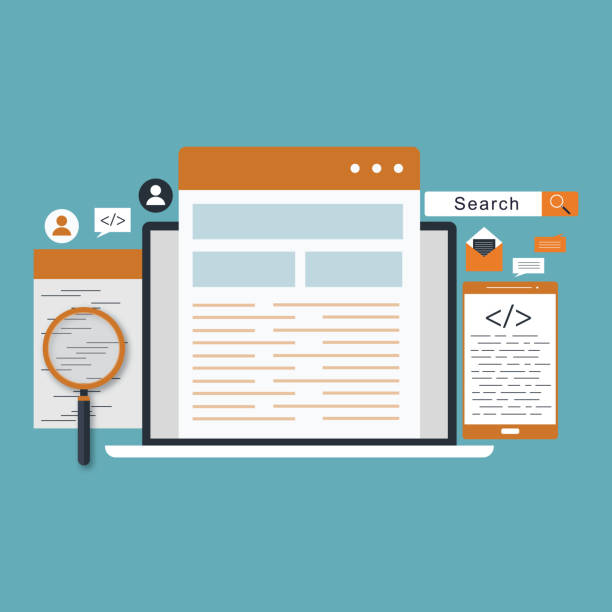An Introduction to the Importance of Secure Website Design in Today’s Digital World

In the current digital age, where the internet has become an inseparable part of our daily lives, #Secure_Website_Design is not an option, but a vital necessity.
Websites are not only showcases for businesses and platforms for providing information, but often serve as places for exchanging sensitive data such as personal, financial, and commercial information.
Therefore, any weakness in #Web_Security can lead to catastrophic consequences, including privacy breaches, information theft, loss of reputation, and even widespread financial damage.
The purpose of this article is to provide a comprehensive and educational guide for a deeper understanding of the principles and methods of secure website design.
We will examine the challenges, solutions, and best practices that developers and website administrators should consider to ensure the security of their platforms.
This specialized topic requires continuous awareness of new threats and methods to counter them, as hackers and cybercriminals are constantly evolving their techniques.
Cybersecurity is a broad concept, of which secure website design is only a part.
Next, we will discuss the foundational principles that will ensure a secure and reliable website design.
Don’t have a corporate website yet and missing out on online opportunities? With professional corporate website design by Rasawab,
✅ Double your business credibility
✅ Attract new customers
⚡ Free consultation for your corporate website!
Fundamental Principles of Secure Design and Layered Architecture

To achieve a secure website design, understanding and implementing fundamental security principles at all stages of development is essential.
These principles include the approach of Defense in Depth, which means using multiple security layers to protect information.
Instead of relying on a single defensive wall, layered architecture enhances security through a combination of security controls at different levels – from the network and server to the database and application code.
This specialized and explanatory approach helps reduce the risk of security breaches, because even if one security layer is broken, subsequent layers can still protect the system.
Other important principles include the Principle of Least Privilege, which states that every user, system, or application should be limited to the minimum necessary resources and access to perform its tasks.
This prevents the misuse of extensive access.
Also, Separation of Duties is another important principle that prevents the concentration of power in the hands of one individual or system.
Implementing these principles from the outset in the secure website development and design process significantly reduces potential costs due to security fixes in later stages and provides a strong foundation for sustainable security.
This proactive approach is a vital part of the secure website design strategy.
User Authentication and Access Management Methods for Secure Website Design

One of the most important aspects of secure website design is user authentication and access management.
This section ensures that only authorized individuals can access sensitive resources and data.
Implementing strong authentication methods, such as using complex and multi-factor passwords (MFA), is of high importance.
Two-factor or multi-factor authentication, by adding another layer of security beyond the password, significantly prevents brute-force and phishing attacks.
In this explanatory and guiding approach, it is recommended that websites use strong hashing algorithms for storing passwords and never store passwords in plain text.
Authentication is only the first step; after that, the access management system must carefully determine what parts of the site and with what level of access each user is permitted after logging in.
This comparison table of authentication methods can help you choose the best option for secure website design:
| Authentication Method | Advantages | Disadvantages | Security Level |
|---|---|---|---|
| Password | Familiar and widespread | Vulnerable to brute-force and phishing attacks | Low |
| Two-Factor Authentication (2FA) | Significant security increase | Requires a second device, slightly more complex for the user | Medium to High |
| Biometric Authentication | Convenience and high security (fingerprint, facial recognition) | Implementation cost, privacy issues | High |
| Digital Certificates | Very high security for enterprise systems | Implementation complexity, requires PKI infrastructure | Very High |
Role-Based Access Control (RBAC) is a specialized and effective method where access is granted based on defined roles for users (e.g., administrator, editor, regular user).
This simplifies access management and reduces the likelihood of human error.
Precise and continuous implementation of these systems plays a crucial role in secure website design and maintaining data integrity.
Encryption and Data Protection in Secure Website Design

Protecting data, both in transit and at rest, is the backbone of a secure website design.
Encryption is a powerful tool to achieve this goal.
For data in transit, using secure protocols like HTTPS, which uses SSL/TLS to encrypt communication between the user’s browser and the web server, is essential.
This educational and guiding step prevents eavesdropping, tampering, or theft of sensitive information by third parties during transmission.
All websites, even those that do not collect sensitive information, should use HTTPS, as it not only enhances security but also positively impacts SEO and website ranking in search engines.
For data at rest (such as information stored in a database), the use of disk encryption or encryption of specific columns in the database becomes important.
This specialized approach protects against information disclosure even if the server is breached and database files are accessed, because the data is stored in an encrypted format.
Cryptographic key management is also a significant and important challenge that needs careful attention; keys must be stored and managed securely to prevent unauthorized access to encrypted data.
Regularly updating encryption algorithms and ensuring they are free of vulnerabilities is an integral part of the data protection strategy.
In summary, a secure website design includes a comprehensive encryption strategy that covers all potential weaknesses and protects user information from unauthorized access.
This is a critical aspect of secure website design.
Does your current corporate website not reflect your brand’s credibility and strength as it should? Rasawab solves this challenge for you with professional corporate website design.
✅ Increase credibility and visitor trust
✅ Attract more targeted customers
⚡ Click for a free consultation!
Periodic Security Auditing and Penetration Testing to Increase Website Security

After secure website design and initial implementation, the work of security does not end.
Periodic security audits and Penetration Testing are vital steps to ensure the stability and effectiveness of security measures.
A security audit involves a comprehensive review of the source code, server configuration, and security processes to identify potential weaknesses and vulnerabilities.
This is an analytical and specialized approach that helps identify problems before they can be exploited by attackers.
Penetration testing, often performed by security professionals or ethical hackers, attempts to simulate the system from an attacker’s perspective and discover vulnerabilities by trying to infiltrate the system.
This includes scenarios such as attempting to access confidential information, corrupt data, or disrupt site functionality.
The results of these tests allow the development team to address security weaknesses before they are discovered and exploited by real attackers.
It is important news that websites handling a large volume of sensitive information should conduct these tests regularly and on a planned schedule.
Also, security updates for software and libraries used on the website, including frameworks, Content Management Systems (CMS), and plugins, should also be performed regularly.
These updates often include fixes for discovered vulnerabilities that, if not applied, can become entry points for attacks.
Without regular audits and penetration testing, even the best secure website design can become vulnerable over time.
The Importance of Secure Development Life Cycle (SDLC) in Secure Website Design

The Secure Development Life Cycle (SDLC) is an approach that integrates security from the very early stages of secure website design and software development.
This means incorporating security considerations into every phase of the development lifecycle, including planning, requirements analysis, design, implementation, testing, and maintenance.
This educational and specialized approach, unlike traditional approaches that considered security as a post-development phase, helps identify and fix vulnerabilities in early stages, which is much more cost-effective and efficient.
In the planning and analysis phase, security risk assessments should be performed, and security requirements carefully defined.
In the design phase, the system architecture should be shaped with a “Security by Design” approach and the use of secure design patterns.
In the implementation phase, developers must follow secure coding and best security practices, and static (SAST) and dynamic (DAST) code analysis tools should be used to identify vulnerabilities.
Security testing, which includes penetration testing and vulnerability assessment, should also be conducted continuously throughout the SDLC.
Security culture must also be embedded within the development team, so that all team members are aware of and responsible for the importance of security.
The DevSecOps approach is a modern example of SDLC that fully integrates security into DevOps processes, making it a shared responsibility throughout the entire development lifecycle.
Implementing an efficient SDLC is the foundation of a secure and sustainable website design.
Countering Common Attacks and Web Vulnerabilities in Secure Website Design

Familiarity with the most common web attacks and methods to counter them is one of the most important pillars of secure website design.
Attackers exploit known vulnerabilities in web applications to gain access to information, manipulate data, or disrupt the system.
One of the most famous lists of vulnerabilities is the OWASP Top 10, which is updated every few years by the OWASP Foundation and includes ten of the most dangerous web security vulnerabilities.
This includes attacks such as SQL Injection, Cross-Site Scripting (XSS), and Cross-Site Request Forgery (CSRF).
To counter SQL Injection, rigorous input validation and the use of Prepared Statements or Stored Procedures for database interaction are essential.
Against XSS attacks, which allow attackers to execute malicious code in users’ browsers, filtering outputs and HTML encoding for any data taken from user input and displayed on the page is crucial.
Countering CSRF also requires the use of CSRF tokens in forms and requests to ensure that requests originate from a legitimate source.
| Attack Type | Brief Description | Countermeasure |
|---|---|---|
| SQL Injection | Injecting malicious SQL code into input fields to access or manipulate the database. | Input validation, Prepared Statements, Stored Procedures. |
| XSS (Cross-Site Scripting) | Injecting malicious scripts into web pages that execute in users’ browsers. | Filtering and encoding outputs, Content Security Policy (CSP). |
| CSRF (Cross-Site Request Forgery) | Forcing the user’s browser to send unwanted requests to the website. | Using anti-CSRF tokens, checking Origin and Referer. |
| Broken Authentication | Weaknesses in authentication mechanisms or session management. | Multi-factor authentication, secure session management, strong password hashing. |
| Security Misconfiguration | Misconfiguration of server, frameworks, or applications. | Secure default configuration, removal of unnecessary functionalities, regular patching. |
In addition, proper error handling and not disclosing sensitive information in error messages (such as server paths or database details) are also part of secure website design.
By understanding and implementing these explanatory and guiding solutions, a secure site can be largely protected against common attacks.
The Role of Security Updates and Patch Management in Secure Website Design

A frequently overlooked but vital aspect of secure website design is the management of security updates and patches.
Software used on websites, including the server operating system, web server (such as Apache or Nginx), database (such as MySQL or PostgreSQL), programming language (such as PHP, Python, Node.js), frameworks (such as Laravel, Django, React), and even Content Management Systems (CMS) like WordPress or Joomla, are all continuously updated by their developers.
These updates often include fixes for discovered security vulnerabilities that attackers can exploit to penetrate the system.
Ignoring or delaying the application of these security patches makes the website highly vulnerable to known attacks.
An important and analytical approach shows that many successful cyberattacks occur not due to complex and unknown techniques, but due to the failure to apply simple and known updates.
Therefore, developing a regular and automated plan for monitoring and applying updates for all website components is a very important guidance on the path to secure website design.
This includes:
- Monitoring security advisories from software vendors.
- Regular scheduling for testing and applying patches in a non-production environment.
- Executing patches in the production environment with minimal disruption.
- Rollback in case of problems.
This process is an integral part of maintaining a secure website design and helps administrators stay one step ahead of new threats.
Failure to comply with this can nullify all previous efforts for secure website design.
Is your company’s website not as professional and trustworthy as it should be? With specialized corporate website design by Rasawab, create an online presence that reflects your credibility and attracts more customers.
✅ Build a powerful and professional brand image
✅ Convert visitors into real customers
⚡ Get a free consultation now!
Incident Response and Data Recovery Plan

Even with the best secure website design approaches and the strongest preventive measures, no system is 100% impenetrable.
For this reason, having an Incident Response Plan and a Disaster Recovery Plan is crucial for any website.
These plans provide step-by-step guidance on how to react in the event of a security incident (such as intrusion, data breach, or DDoS attacks) and how to recover the system and data afterward.
This is an important analytical and guiding section.
An effective incident response plan should include the following steps:
- Identification: Early detection of the incident (using monitoring and alert systems).
- Containment: Preventing the spread of damage and isolating infected or at-risk sections.
- Eradication: Removing the intruder and the vulnerabilities that led to it.
- Recovery: Restoring systems and data to a normal and secure state.
- Lessons Learned: Analyzing the incident to prevent its recurrence in the future and continuously improving secure website design.
The disaster recovery plan also focuses on regular backups of data and source code, and the ability to quickly restore them in case of loss or corruption.
Backups should be performed periodically, in secure locations, and preferably offline or in a separate cloud space.
Periodic testing of backup plans is also essential to ensure their accuracy and effectiveness.
The absence of these plans can lead to irreparable damage and complete loss of information during a crisis.
This aspect of secure website design acts like an insurance policy for the survival of the business in the online space.
User Awareness and Education for Website Cybersecurity

In any comprehensive secure website design approach, the human factor is one of the most important links.
Regardless of how technically secure a website is designed, if its users are not sufficiently security-aware, they can still be an entry point for cyberattacks.
This educational and engaging section addresses the critical role of user education and awareness.
Social engineering attacks, such as phishing and spear phishing, are among the most common methods attackers use to exploit user trust and unawareness.
Users should be educated on how to:
- Create strong and unique passwords and protect them properly.
- Identify suspicious emails and messages and never click on unknown links.
- Understand the importance of Two-Factor Authentication (2FA) and enable it.
- Recognize the signs of a secure website (such as HTTPS in the address bar and a green lock).
- Be cautious about sharing personal information online.
Websites can educate their users by providing awareness messages during registration or login, explanatory articles in the FAQ section, or even through awareness campaigns.
Creating an environment where users feel secure and are aware of their security responsibilities significantly reduces security risks due to human error.
For example, you can display a thought-provoking message about “Do you know how secure your password is?” or “Are you ready for a phishing attack?”
Continuous education is essential not only for increasing website security but also for creating a safer and more responsible online community, and it is an important part of the secure website design strategy.
Frequently Asked Questions
| Number | Question | Answer |
|---|---|---|
| 1 | What does secure website design mean? | Secure website design refers to a set of measures and methods used to protect a website against cyberattacks, unauthorized access, data breaches, and other security threats. Its goal is to maintain the confidentiality, integrity, and availability of information. |
| 2 | Why is website security important? | Website security is crucial for maintaining user trust, protecting sensitive information (such as personal and financial data), preventing financial losses, preserving brand reputation, and complying with legal regulations (such as GDPR). A security breach can lead to loss of customers and heavy penalties. |
| 3 | What are some of the most common security attacks against websites? | The most common attacks include SQL Injection, XSS (Cross-Site Scripting), CSRF (Cross-Site Request Forgery), Brute Force, DDoS attacks, Broken Authentication, and Missing Function Level Access Control. |
| 4 | What is the role of SSL/TLS certificates in website security? | SSL/TLS certificates (which result in an HTTPS address) are used to encrypt data exchanged between the user and the website server. This prevents eavesdropping or tampering with sensitive information such as passwords and credit card details during transmission and verifies the website’s authenticity. |
| 5 | How can SQL Injection attacks be prevented? | To prevent SQL Injection, Prepared Statements or ORM (Object-Relational Mapping) with validated parameters should be used. Additionally, thorough filtering and validation of user inputs (Input Validation) and applying the principle of least privilege in the database are essential. |
| 6 | What is HTTP Strict Transport Security (HSTS) protocol and how does it help security? | HSTS is a web security policy that tells browsers to load the website only via an HTTPS connection, even if the user enters the address with HTTP. This prevents Downgrade attacks and cookie hijacking on public Wi-Fi networks. |
| 7 | What is the importance of regular software and plugin updates in website security? | Regular updates of the Content Management System (CMS), plugins, themes, and other software components of the site are crucial for addressing discovered security vulnerabilities. Developers continuously release security patches, and failing to update can leave the site vulnerable to known attacks. |
| 8 | What measures can be taken to enhance the security of the website administration section (admin panel)? | Measures include changing the default admin panel path, using strong passwords and two-factor authentication (2FA), restricting access to specific IPs, using CAPTCHA on login pages, monitoring logs, and continuously updating the CMS. |
| 9 | Why is filtering and validating user inputs (Input Validation) important? | Filtering and validating inputs helps prevent the injection of malicious code or unauthorized data through forms, URLs, or other user input sections. This prevents attacks like XSS and SQL Injection that exploit invalid inputs. |
| 10 | Name a few common tools or services for checking and enhancing website security. | Tools like Web Application Firewalls (WAF), vulnerability scanners (e.g., Acunetix, Nessus), Intrusion Detection and Prevention Systems (IDS/IPS), CDN services with security features (e.g., Cloudflare), and periodic Penetration Testing can enhance website security. |
And other services of Rasawab Advertising Agency in the field of advertising
Smart Conversion Rate Optimization: Revolutionize user engagement with precise audience targeting.
Smart Conversion Rate Optimization: A blend of creativity and technology to boost site visits through appealing UI design.
Smart Marketing Automation: An effective tool for improving SEO rankings with precise audience targeting.
Smart Custom Software: An effective tool for online growth using real data.
Smart Google Ads: A combination of creativity and technology to improve SEO rankings through custom programming.
And over hundreds of other services in internet advertising, advertising consultation, and organizational solutions
Internet Advertising | Advertising Strategy | Advertorial
Resources
Complete Guide to SSL Certificate for Website Security
Principles of Secure Coding and Vulnerability Prevention
Web Security – Wikipedia
Key Tips for Protecting Your Site Against Cyberattacks
? Ready to transform your business in the digital world? Rasawab Aferin, with expertise in secure website design, professional SEO, and content marketing, paves your path to success and visibility. With us, guarantee the future of your online business.
📍 Tehran, Mirdamad Street, next to Bank Markazi, Kazerun Jonubi Alley, Ramin Alley, No. 6




